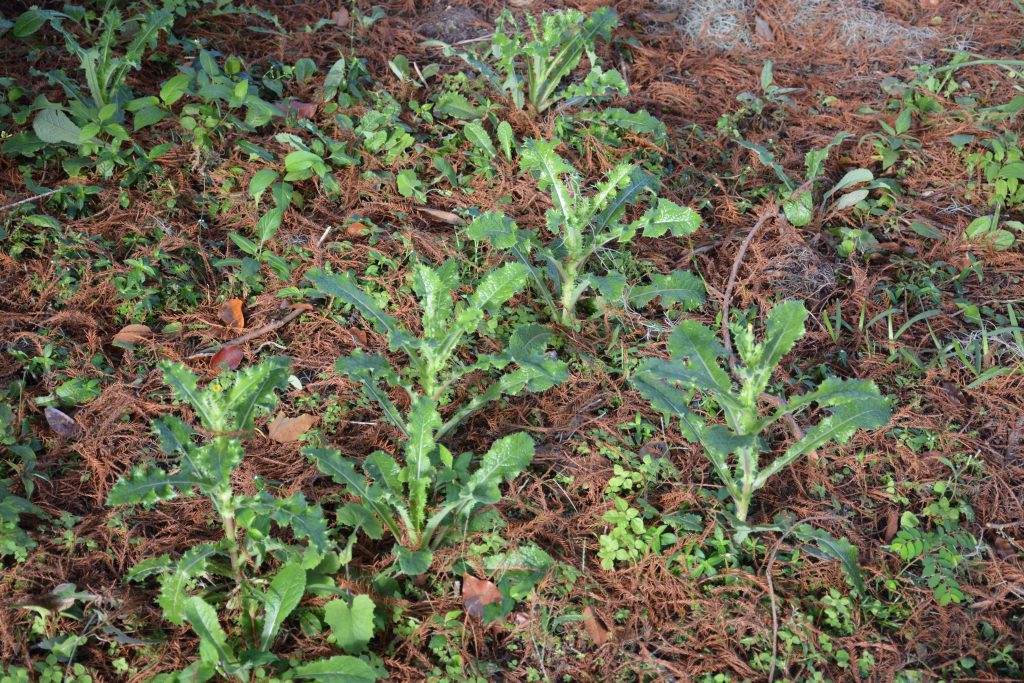
Spiny Sow Thistle is up and ready for foraging. It’s better when young whereas its relative, the Common Sow Thistle, stays edible longer. Photo by Green Deane

Finding Mistletoe during the 13th annual Urban Crawl in Winter Park. Photo by Rick and Angel Luther.
Today, as I write, is the shortest day of the year but we are still foraging strong. Our 13th annual Christmas Urban Crawl is over and was a success. To the left is a photo of me pointing out some mistletoe but as usual it failed to generate any kisses (I am beginning to think that is a myth.) The prolific appearance of False Hawk’s Beard during that event prompted me to do another video on them yesterday and a new video on sow thistles is in the works as soon as I can find a lot of Sonchus Oleraceus to shoot.
We have two species of sow thistle locally. Not a true thistle they are among the more milder seasonal greens with only perhaps Amaranth being more mild. Although Sow Thistles are commonly called “thistles” they are not in the genus Cirsium and do not draw blood like true thistles. True thistles are well-armed with needle-sharp spines. While the Sow Thistle above, Sonchus asper, can look intimidating it’s mostly just show in that most spines are soft until it gets older. The other species, Sonchus oleraceus, looks more friendly. A few minutes of boiling takes away any bitterness completely (unlike wild lettuce which always stays slightly bitter.) I have an old video on the sow thistles and to read more about them go here.
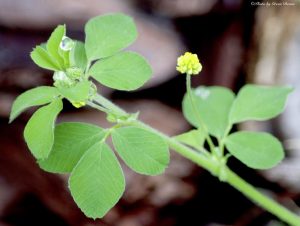
Note the long stem on the middle leaf.
Saw Black Medic for the first time this season. It’s generally considered edible and like many weeds is from Europe. That kind of excludes it from being a significant Native American food (though some sources call it that… It’s a long story.) The headache is that from a distance of about five or six feet (where most people’s eyes are from the ground) Black Medic can look like Hop Clover. Here’s quick way to tell them apart: Hop Clover tends to have red stems, Black Medic has green stems covered with fine white hair and has a longer stem on the center leaf. After the two species go to seed they are easy to sort out: Black Medic has black seeds… hence the name. Hop Clover has brown seeds. You can read more about it here.
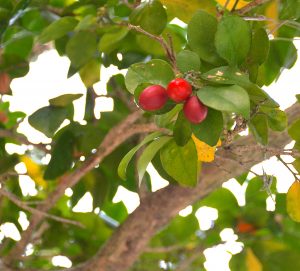
Orangre Jassamine has edible fruit. Photo by Green Deane
During the Urban Crawl Rose Ann pointed out a tree in Winter Park’s park I had not noticed before — not unusual. It was conveniently labeled: Orange Jassamine (it has dozens of other names including Murraya paniculata.) I’ve written an article about it for the website but it’s not published yet. Surprisingly the tree is used basicially for flavoring though the fruit are edible. That edibility is marginal. We tried a few. They have an intense citrus flavor that does not fade for a long time. Even munching on Society Garlic couldn’t abate the citrus taste. My speculation is it might make a good marmalade candidate though on the red side rather than orange. As the species is also a vector for the “greening disease” it no doubt is on the state’s hit lists of ornamentals to be eliminated.
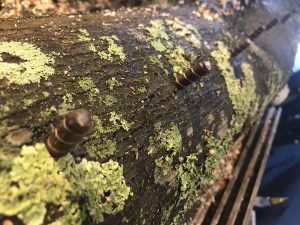
Inoculation maple with lion’s mane plugs. Photo by Green Deane
How is growing mushrooms like making wine? In terms of materials and process they are very different. However, what they do have in common is time and having to wait to see if one did it right or not. Like lacto-fermentation that turns cucumbers into pickles, making wine is a basic recipe with variations. So is mushroom cultivation. But even if you do it right it can take years to find out if you were successful. I have some homemade Malbec that is drinkable at a year old. But a Second-Hand Rosé needs another year a least. I think my Brazilian Pepper Mead will need five years. And so with that in mind I started several batches of edible mushrooms on maple logs. A couple of streets away a lawn maple was cut down and the trimmer is tardy removing it. The owner said I could have as much as I wanted. I have hauled home about a ton, small pieces for smoking food, and large pieces for mushroom farming. Anything left over will be sized and cured for campfiring. In a year or two I might have some Lion’s Mane, Velvet Foot Enoki, Black Popular Piopinnos, and Blue Oyster Mushrooms. What I have learned from all of this is if I ever have a tree cut down I will immediately inocuate the stump with spores. A large stump should produce mushrooms for many years.
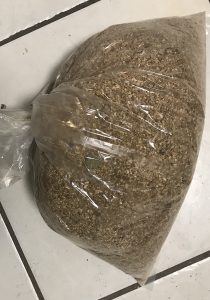
Sawdust and wheat bran might grow some Oyster Mushrooms.
For a more immediate mushroom experiment I collected the sawdust from sizing the maple for smoking. Then I steamed it for a couple of hours, added wheat brand (for the nitrogen) and some mycelium that came with the oyster mushroom plugs. The bigger question was what to put it all in… I had some old clear oven bags. I had them for windshield reflector solar ovens demos about a decade ago: Big, tough, clear, on hand and already paid for…. If this works it should produce mushrooms within in a couple of months… the logs in a year or so.

Classes are held rain or shine (but not during hurricanes.)
Foraging Classes are light during the holiday season. I have one locally the day after Christmas and a test one a week later beach side. Sunday’s class might start out a little chilly. The day after New Year’s weather is anyone’s guess.
Sunday December 26th, Mead Garden: 1500 S. Denning Dr., Winter Park, FL 32789. 9 a.m. to noon. Meet at the bathrooms. The park entrance is on South Denning. Some GPS directions get it wrong.
Sunday January 2nd, as Monty Python used to say, “and now for something different.” Let’s meet at 10 a.m. (at the bathrooms) and wander around Lori Wilson Park, Cocoa Beach, for a couple of hours. No fee. I did a short private class there a couple of years ago. Not sure it is extensive enough for a regular class. If the weather’s pleasant it will be a nice way to start the new year. If cold dress warmly as it should be windy. 1500 N. Atlantic Avenue, Cocoa Beach Fl 32931.
For more information, to pre-pay or sign up go here.

Green Deane videos are now available on a USB.
My nine-DVD set of 135 videos has been phased out and replaced by a 150-video USB. The USB videos are the same videos I have on You Tube. Some people like to have their own copy. The USB videos have to be copied to your computer to play. They’re a nice Christmas gift sent by First Class Mail. If you want to order the USB go to the DVD/USB order button on the top right of this page or click here. That will take you to an order form. I’d like to thank all of you who ordered the DVD set over the years which required me to burn over 5,000 DVDs individually.

Green Deane Forum
Want to identify a plant? Perhaps you’re looking for a foraging reference? You might have a UFO, an Unidentified Flowering Object, you want identified. On the Green Deane Forum we — including Green Deane and others from around the world — chat about foraging all year. And it’s not just about warm-weather plants or just North American flora. Many nations share common weeds so there’s a lot to talk about, such as the one to the left. There’s also more than weeds. The reference section has information for foraging around the world. There are also articles on food preservation, and forgotten skills from making bows to fermenting food. Recent topics include: California Wild Mushroom Parties, A Good Reason To Eat Wild Garlic, Black Walnuts and Amaranth, Sea Salt and Plastic, Wild Mustard? Heavy Metals. Oriental Persimmons. What is it? Pine Cough Drops and Needles, Skullcap, Malodorous Plant? Another NJ Tree, Maypop? Roadside Plant, Unknown in Sudan, Please Help Identify, and Preserving Prickly Pear Bounty. You can join the forum by clicking on the button on the upper right hand side of this page.
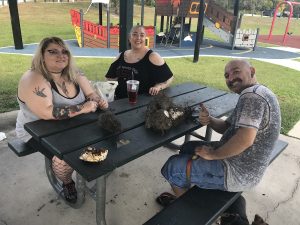
All smiles after digging up some D. alata roots. Photo by Green Deane
Foraging class Sunday saw us digging four Dioscorea alata roots. Chef Steven Karter likes to make shepherd’s Pie out of them, and mashed potatoes. Rumor has it they also kind of naturally taste like French Fries. I’m salt, pepper and real butter myself. This time of year the invasive D. bulbifera has usually died back but the altata can still be found rather easily. In the spring the trend is reversed, the bulbifera comes up first and a few weeks later the alata. We do not eat the air potato of either species. The alata root is the largest calorie payoff in Florida. But it can be tough to dig out as this one was growing among camphor roots. I need to remember to carry a shovel and an ax in the vehicle for such occasions.
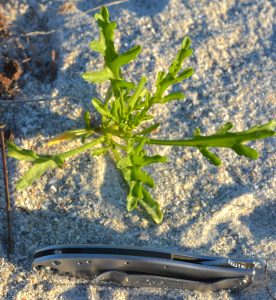
Sea Rocket is just starting its seasonal run. Photo by Green Deane
Near a beach? Sea Rocket is starting its season. We should see some in the January second class. We have two species of Cakile or Sea Rocket. They show themselves in our winter and preferably on the beach above the rack line. You can also find them blossoming in coastal dunes. The leaves are a bit fleshy but as they are in a tough environment that helps them preserve water. While Sea Rocket can be found along most coasts of the United States, Maine to Washington State, Florida has its own variety, C. lancelolate. There is a video on them here and you can read more about them here.
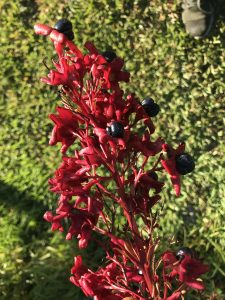
The Glory Bower is not edible but has some relatives that might be.
The Harlequin Glorybower, Clerodendrum Trichotomum, has a very showy calyx. A native of Asia, Clerodendrum means fate tree, referencing questionable medical uses, and trichotomum which means three trunks, which it apparently has often. But it has edible relatives: C. serratum: Young leaves and tops eaten raw as a side dish or roasted briefly and served with a hot pepper sauce. C. paniculatum, the Pagoda Flower, is also listed by some as having edible parts and is a common ornamental locally. I’ve never investigate it. It’s quite a shower now in Mead Garden (end of the board walk) and Bayshore Park, east end by the Brazilian Pepper.
This is my weekly newsletter #487. If you want to subscribe to this free newsletter you can find the sign-up form in the menu at the top of the page.
To donate to the Green Deane Newsletter click here.


Good luck with your mushroom cultivation. I’m good with the bag effort but inoculating logs or the earth has not proven as successful as I had hoped.